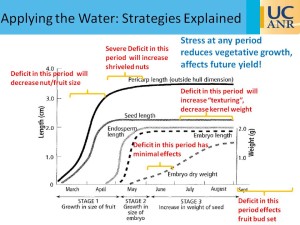Many farmers across the state will be impacted by this year’s drought. Within almonds, there has been a lot of research conducted to determine better strategies to apply water. A publication developed through UC ANR highlights the two more consistent, easier applied strategies. These strategies, along with the effects of water stress, are highlighted below.
The strategy applied should be based on water available. If 15% or less than of the estimated full almond evapotranspiration (ETc) is available, Hull Split strategic deficit irrigation (SDI) could be considered. If the reduction is greater than 15%, the strategy of proportional deficit irrigation should be considered. An example of both strategies is given in figure 1.

Hull split Strategic Deficit Irrigation: Hull Split SDI maintains full irrigation until the completion of kernel fill. After kernel fill and until 90% hull-split, irrigation is applied only when trees reach SWP values of -14 to -18 bars (Shackel, et al, 2004). Field research has shown that this technique will decrease water use by as much as 34% during this period, reducing total seasonal water use by about 15%, while having minimal impacts on current and next season’s crop (Stewart, et al, 2011). In practice, it can be difficult to fine-tune the irrigation schedule to this SWP threshold. Many growers will initially reduce water applications by 50% around mid-June and will adjust the amount of subsequent irrigations once stress levels increase and soil moisture depletion occurs. Water should be applied prior to harvest to improve hull-split and reduce hull tights (Prichard, et al, 1994). This strategy is a particularly effective method for reducing hull rot (Tetviotdale, et al, 2001), if that is a problem, but it also improves harvest-ability by reducing the force and time required for shaking, which can benefit the long term health of the orchard.
Proportional Deficit Irrigation: If the pressure chamber is unavailable, or the anticipated seasonal water deficit is greater than 15% for the seasonal ETc, then reduced water applications can be made by applying a fixed proportion of ETc. In this method, the amount of water available for the season should be calculated as a percentage of full ETc. This percentage should be applied to spread the deficit evenly across the season. In other words, if it is determined that enough water is available to supply only 55% of ETc for the whole season, then each irrigation would match 55% of the determined ETc for that irrigation period. An example is given in table two. Current season and future yield loss should be expected when using this strategy, but research has shown this to be the most effective strategy in minimizing losses (Goldhamer, et al, 2006) for large irrigation deficits

Effects of Severe water stress on almond growth and development. Water stress reduces the ability for the tree to produce carbohydrate, which is critical for fruit, vegetation, and bud development. The impacts are explained in greater detail in future ANR pub titled “Drought Management for California Almonds,” but are highlighted in figure 2. Please note that it is difficult to pinpoint exact stresses, and some of the described effects are anticipated rather than observed. SDI times the stress during the June/July period to have minimal impact on kernel and bud development. PDI spreads the level of stress evenly through the season to reduce the application of a severe stress at a time point, mitigating some of the stress effects described in figure 2.


Art Young
March 10, 2015You name SDIs and ETcs; however, you don’t define them at the start of your article. Is there a source of these terms
David Doll
March 11, 2015Art,
Sorry for my oversight. I have corrected the article to state the full term.
David
Ernie
July 18, 2015Question: I’m farming 9 year old Butte-Padre that are flood irrigated. I’m planning on installing drip this fall. What will be the effects of the root system being irrigated over a wide area, to a concentrated area. Not sure if this is even an issue, but I gotta ask.
David Doll
July 21, 2015Ernie,
Reports from previous farmers who have converted to drip systems have suggested that the trees struggle with the change, but recover. From what I could gather, the best results are when the system is installed and used from the spring onward. Trees will have to re-adjust their root development to the wetting pattern. This probably will take a season based on the age of the trees.
If previously vigorous (full canopied), they will lose some vigor as the re-adjust. If lower vigor (less than 50% canopy), they may actually benefit from the site specific delivery of nutrients and water.
The best advice is learn how to use the system you plan to install. Know how much water is applied per acre per hour and match the trees usage as calculated through ET estimates. Make sure to keep up on the maintenance of the system too – hoses need to be flushed and screen filters checked or it will lose efficiency.
Good luck!
David
2015 Top Ten Articles - The Almond Doctor
December 31, 2015[…] Drought Management for Almond: Drought was a major challenge for many operations in 2015. This article discusses strategies to […]